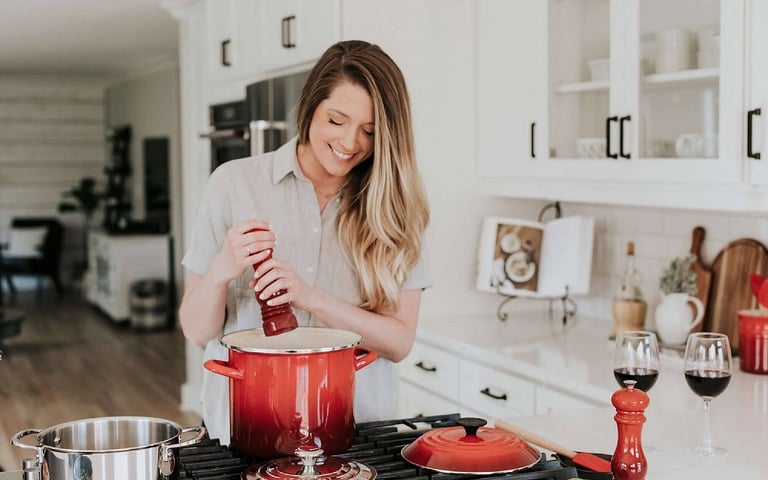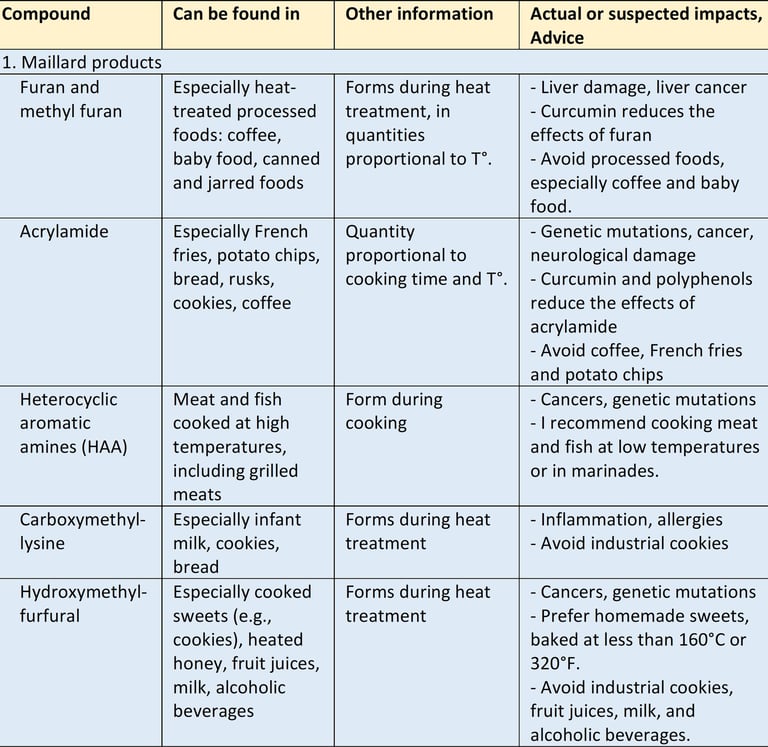Cooking methods and utensils: why it matters?


Cooking methods and utensils can be a source of toxic molecules that are best avoided. Same for storage and packaging methods
Let's start with cooking methods. I won't go into the heat treatments of processed food here but will limit myself to cooking that you can do at home. Let's take a concrete example: when you roast a meat to the point where there are brown parts which give off aromas, we speak of "glycation" or the "Maillard reaction". When this meat is ingested, an inflammatory cascade and oxidative stress occur within the body, which can lead to cardiovascular and neurodegenerative diseases. The term "advanced glycation products" is more widely used to refer to all those reaction products that attach a glucose to the amine function of a protein (and those that oxidize a fatty acid with a glucose).
Here's a table I've put together to list the harmful compounds that can be formed and, above all, what you can do to limit the damage (I'm leaving out the compounds found mainly in processed foods, such as furan, methyl furan, carboxymethyl lysine and hydroxymethyl furfural):
It's therefore important to opt for gentle, slow, low-temperature cooking methods, to avoid frying and to avoid grilling meat. Non-toxic cooking methods include steaming (in a steamer rather than in a pressure cooker, which destroys more nutrients), slow cooking at low temperature in a casserole or oven (possibly in papillotes, using parchment paper rather than aluminum foil) and cooking in a bain-marie. Cooking in water can also be used from time to time, if the water is consumed (into which most of the vitamins and minerals will have migrated). Consumption of antioxidants and fiber can reduce the formation or effects of deleterious compounds formed during cooking: turmeric, polyphenols, aromatic herbs, etc.
When it comes to cookware, I don't recommend nonstick pans, even if their nonstick coating isn't scratched, as its production involves toxic substances. Avoid aluminum and peroxide-catalyzed silicone (platinum-catalyzed silicone seems okay). I recommend inert utensils: 18/10 stainless steel, natural cast iron, glass, stone, and untreated wood. Ceramic is theoretically inert, but its glaze may contain toxic substances. Stainless steel 18/10 may seem a little daunting to clean, but if you run some water over it after use and wait a few hours, everything comes off quite easily. That's what I use.
As far as preservation methods are concerned, pasteurization, refrigeration, lacto-fermentation, and freeze-drying are all risk-free, although vegetables gradually lose their vitamins in the fridge, which is why it's a good idea to buy them fresh and eat them quickly. Salting, smoking, drying, canning, ionizing radiation, and jamming all present risks. You should also avoid eating vegetables bought already cut or in bags, as they have already lost many of their vitamins. If they are packaged in a so-called protective atmosphere, they can also disrupt the intestinal microbiota. Very important: oils should be stored in dark glass bottles to limit their oxidation by light. Oils rich in polyunsaturated fatty acids, such as rapeseed, flaxseed, hemp or camelina oil, should also be kept in the fridge to prevent rapid oxidation at room temperature.
Finally, when it comes to packaging, any food wrapped in polystyrene should be avoided. Acidic foods, such as tomatoes or lemons, should not be wrapped in aluminum foil (migration of aluminum into the food), and fatty foods should not be wrapped in cling film or other plastic containers (migration of plasticizers into the food). Glass is the healthiest preserving material, as it’s totally inert. It is also the ideal container for reheating in the microwave (if you use the microwave, which is best avoided as it alters the structure of the food). Finally, be careful with cans and plastic packaging (including yoghurt pots, water, juice and oil plastic bottles and plastic cutlery), as they may contain bisphenols and phthalates, which are endocrine disruptors. As a precaution, if you can't avoid them, don't expose them to heat or refrigeration, to avoid increasing the possible migration of harmful particles into whatever they contain.
To find out more, also read these articles:
On the links between cancer and diet: https://isabellemaesnutrition.com/en/cancer
On oxidation and glycation: https://isabellemaesnutrition.com/en/oxidation-glycation
Kitchen picture by Becca Tapert


